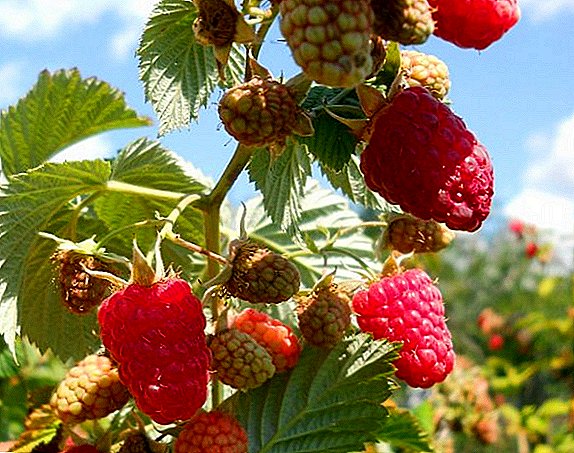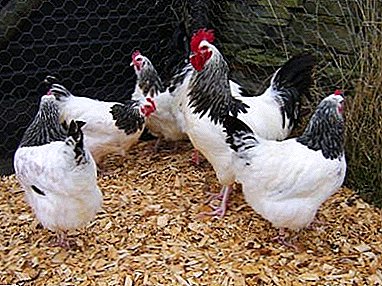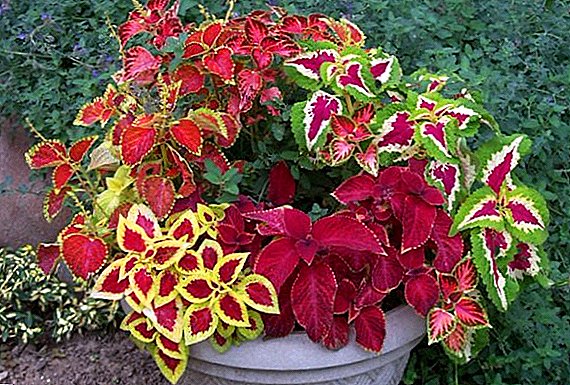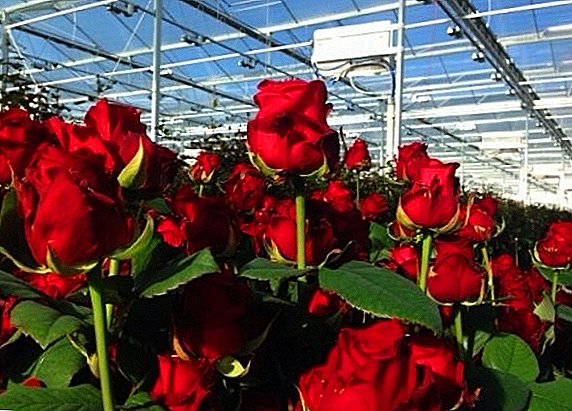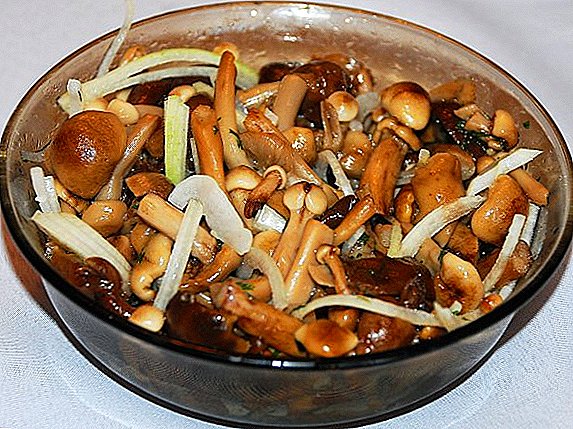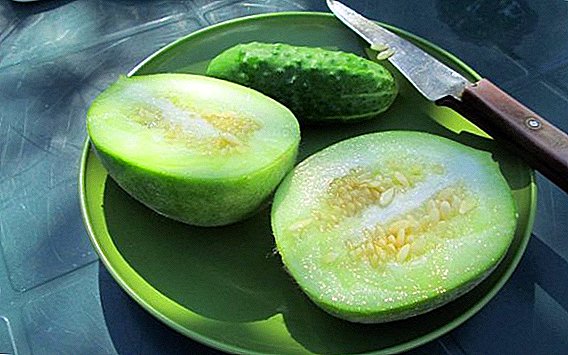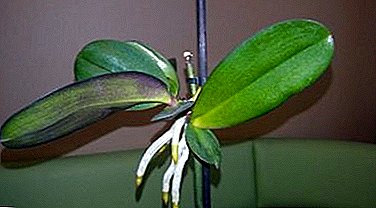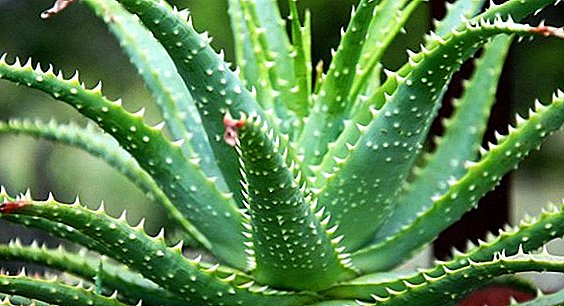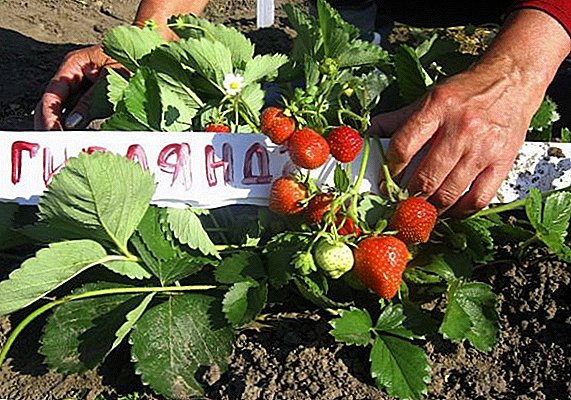 The variety of strawberries "Garland" is remontant, as it pleases with new flowering and bright fruits over a long period. “Garland” is also called garden strawberry because of its appearance features: a curly bush not only gives delicious berries, but is also very decorative. In this article we will talk in detail about the botanical description of the variety, as well as consider the basic rules of planting and care.
The variety of strawberries "Garland" is remontant, as it pleases with new flowering and bright fruits over a long period. “Garland” is also called garden strawberry because of its appearance features: a curly bush not only gives delicious berries, but is also very decorative. In this article we will talk in detail about the botanical description of the variety, as well as consider the basic rules of planting and care.
Biological description and appearance
"Garland" can be found not only in the gardens. She regularly pleases the eye to the owners of ornamental gardens and landscape parks. A botanical description will help to find out why this variety is valued not only by berry lovers, but also by the owners of decorative plantings.
Find out what is special about remontant varieties of strawberries, raspberries and strawberries.
Bush
The bush has almost the correct spherical shape. The density of leaves is average, which is typical of many remontant varieties. The leaves are smooth, have a green color with a slight bluish tinge. They are completely covered with whitish pubescence, have moderate ribbing. 
Did you know? Strawberry is an excellent antidepressant and is able to replace many synthetic drugs for the nervous system. This property is due to the presence in the berries of almost all the vitamins of group B. Only 150 g of strawberries a day will protect your body from neurosis and depression.
Inflorescences are localized near the leaves, have a multi-flowered type. Mustache different greenish-pink color. The bush is not tall, but a large number of whiskers form on it, which allows the flowers to grow on new sockets. Strawberry "Festoon" has high decorative qualities. This branching plant is a true decoration of decorative parks, verandas, balconies and rock gardens.
Fruit
Berries that ripen in the early stages of the growing season are often of large size (large - up to 30 g, maximum oval and fragrant). In the future, the strawberry becomes oblong, but the strawberry flavor does not lose until the end of the growing season. The surface of the berries has a moderate shine and red-pink color.
The flesh is quite juicy and soft. The interior of ripe berries is distinguished by a light red tint, juiciness and a high degree of density.  Practically at all stages of the growing season, the average number of berries on one bush remains constant, which attracts lovers of remontant strawberry varieties.
Practically at all stages of the growing season, the average number of berries on one bush remains constant, which attracts lovers of remontant strawberry varieties.
Learn how to make a row-pyramid for strawberries with your own hands.
Varietal features
Before you plant the "Garland" on your site, you need to carefully examine its varietal characteristics.
Drought resistance and frost resistance
This variety of strawberries has an average degree of drought resistance. In regions with hot summers and minimal rainfall, “Garland” will bear fruit less efficiently. To normalize these indicators, plantings should be properly maintained: they should be planted in partial shade areas, should be watered regularly and moderately, and often mulched.
Important! After the autumn planting strawberries need to mulch. And after 2-3 weeks - to cover with spruce branches or straw, so that winter frosts do not harm unadapted plants.
 Frost varieties are also average. In the northern regions of Russia and in Siberia, this type of strawberry can be planted only in enclosed spaces (on balconies or in greenhouses). The Ural company Miass Sortsemovosch has published data, according to which the garden strawberries Girlyanda practically cannot withstand the fierce winters of the northern part of Russia. These data say that only 30% of strawberry plantations were able to safely winter through the foothills of the Ilmensky Mountains.
Frost varieties are also average. In the northern regions of Russia and in Siberia, this type of strawberry can be planted only in enclosed spaces (on balconies or in greenhouses). The Ural company Miass Sortsemovosch has published data, according to which the garden strawberries Girlyanda practically cannot withstand the fierce winters of the northern part of Russia. These data say that only 30% of strawberry plantations were able to safely winter through the foothills of the Ilmensky Mountains.Ripening period and yield
“Garland” is a highly productive and strong strawberry variety, which, under ideal conditions of care and in the corresponding climatic zone, bears fruit from early May to mid-October. Average yields on large plantations reach 1-1.2 kg of berries from each bush. Some entrepreneurs slightly increase these indicators using special equipment for alternate fertilizers and irrigation.
Application
Berries varieties "Garland" refers to dietary products (100 g contains only 46 kcal). This strawberry can be eaten raw, mashed with the addition of sour cream, prepare juices and liqueurs. Many people prefer to freeze fragrant strawberry berries in order to feast on strawberry dessert in a snowy winter evening. By the way, from the berries of the Garland variety, excellent home-made wine, marmalade and even candied fruits are obtained. 
How to choose strawberry seedlings when buying
It is best to buy seedlings of garden strawberries at proven nurseries, which have a lot of positive reviews and provide a guarantee for their goods. You can purchase seedlings at different times of the year. If you make a purchase in early summer, then in August you can get the first harvest. Autumn buying and planting are rarely made, because then strawberry bushes will begin to bear fruit only in a year. It is best to buy seedlings "Garland" in early spring. In this case, you can get the first harvest by the beginning of the first month of summer.
Did you know? The largest strawberry berry in history had a weight of 231 g. It was picked from a bush in Kent, USA, in 1983.
Garden strawberries are unstable to various diseases. This should be considered when choosing seedlings, as some seedlings may already be infected, for example, with powdery mildew. At the time of purchase, it is necessary to evaluate the health of seedlings and pay attention to the following nuances:
- Leaf spotting indicates the presence of a fungal disease. In the spring, it is better not to buy such seedlings, but at the end of summer a small fine spot on the leaves is quite acceptable.
- Do not buy seedlings whose leaves are wrinkled. This indicates the defeat of plants microscopic strawberry mite.
- Seedlings with pale leaves to buy is strictly prohibited. This feature most likely indicates a dangerous disease - late blight necrosis.
VIDEO: HOW TO CHOOSE THE STRAWBERRY SEEDLINGS
Below we present a number of features that meet the quality healthy strawberry seedlings:
- The leaves are green, strongly pubescent, have no spotting and damage.
- The horn must be thick (at least 7 mm). The thicker the horn, the higher the degree of yield of the strawberry bush.
- The root system of seedlings in cups or cassettes should completely fill the soil volume.
- At least 3 leaves should be formed on the outlet.
- Roots must be healthy, have no damage and rot. Rot indicates the presence of a fungal disease.
Growing conditions
Experts say that the maximum yield of strawberries falls on the first 3 years after planting. That is why the bushes are recommended to replant or transplant every 4 years. Ideal predecessors of the Garland variety are:
- parsley;
- peas;
- garlic;
- legumes;
- carrot;
- corn;
- bow.
Reforestation varieties also include strawberries "Fresco", "Mara de Bois", "Albion", "Elizabeth 2", "Cinderella".
 For planting strawberries choose flat places. This strawberry variety prefers soils with an average acidity (5.0-6.5 pH). Groundwater at the landing site should lie at a depth of 60-80 cm from the surface. Sandy loams with a humus content of not more than 3% are considered the optimal soil for strawberries.
For planting strawberries choose flat places. This strawberry variety prefers soils with an average acidity (5.0-6.5 pH). Groundwater at the landing site should lie at a depth of 60-80 cm from the surface. Sandy loams with a humus content of not more than 3% are considered the optimal soil for strawberries.
Preparatory work
The process of preparing the seat includes several steps:
- cleaning of the chosen place from garbage, foliage, branches, stones, etc .;
- digging up of soil and fertilizer of a future bed;
- marking and formation of beds.
Important! Fertilizing strawberries with nitrogenous fertilizers during the period of active fruiting should not be. Nitrogen stimulates the growth of foliage and shoots, as a result, the berries grow small.
If the landing work will be carried out in the spring, then the digging of the site should be carried out in late autumn. When planting in summer or autumn, loosening of the soil should be carried out a month before the beginning of planting. It is necessary to dig up the earth on the bayonet of a shovel, otherwise a strongly compacted soil will interfere with the normal growth and development of young strawberry roots.
During digging, fertilizers are applied according to the following rules (per 1 sq. M):
- 6-7 kg of compost;
- 100 g of superphosphate;
- 50 g of urea;
- 50 g of potassium salt.
 Composting In the summer, planting works are carried out only after heavy rainfall. In the spring, it is not necessary to wait for the rain, because at this time of the year the soil already has a high level of humidity. The marking of the beds can be carried out immediately during the preparation, so you can determine the number of strawberry bushes you need. You will learn about the rules and landing pattern in the next paragraph.
Composting In the summer, planting works are carried out only after heavy rainfall. In the spring, it is not necessary to wait for the rain, because at this time of the year the soil already has a high level of humidity. The marking of the beds can be carried out immediately during the preparation, so you can determine the number of strawberry bushes you need. You will learn about the rules and landing pattern in the next paragraph.
Landing rules
Planting work in the spring should be as early as possible. In the southern regions of Russia and Ukraine, as well as in Moldova, seedlings can be planted at the end of March. In other regions, it is necessary to wait for the moment when night frosts will completely disappear. In general, planting strawberries "Garland" in the open ground can be from late March to mid-October.
Find out what features of planting and care for remontant strawberries.
Autumn planting is best carried out only when the average daily temperature is established within + 2 ... +4 ° C. At higher temperatures, the bushes will begin to bloom and may die. In summer, planting starts in the evening and preferably on an overcast day. Under the hot rays of the sun unadapted seedlings fade quickly and die. 
Did you know? In Belgium, you can visit the museum, which is entirely devoted to strawberries.
So that the strawberry "Garland" got accustomed on your site and was distinguished by high yield, you should observe the following planting rules:
- Garden strawberries of this variety are best planted in open ground in spring.
- This variety of strawberries is strongly branched, and when planting, you need to keep a distance of 70-80 cm between the holes. Thickened plantings will lead to the fact that there is little sunlight inside the bush.
- The depth of the landing holes should be 40-45 cm.
- In each well, be sure to make a small mound.
- As soon as the root system of the seedlings is covered with earth, the upper layer must be compacted. After this procedure requires abundant watering.
- In the first 7-10 days after planting the plantation with strawberries should be watered daily. If there is a hot sunny weather outside, then in the daytime the beds should be pritenyat.
VIDEO: AUTUMN LANDING STRAWBERRY
Home care
Many summer residents and gardeners know that it is necessary to care for remontant strawberry varieties more carefully and throughout the growing season. Otherwise, fruiting will not be so active, and strawberry plantations can affect various pests and diseases.
There are some basic rules for caring for the garland garden repair strawberry:
- On hot summer days, watering should be done every 2-3 days. Under each bush pour about 2 liters of warm water. During the rainy season irrigation activities are suspended. We should not forget about fertilizing berry bushes with liquid fertilizers (during irrigation, using, for example, herbal infusions characterized by a rich composition of macro- and microelements).
- Some time after precipitation or irrigation, the soil around strawberry bushes needs to be loosened. Such procedures improve soil aeration and prevent the development of fungal diseases of the root system of plants.
- Weeding should be carried out as weeds appear. They often appear after a period of rain and prevent strawberries from producing fruit normally. We do the weeding carefully, only superficially, so as not to damage the roots of the strawberry bushes. Immediately after weeding, try to remove some excess mustache, which draws on itself a lot of useful elements and worsen the overall yield of the crop.
- During the period of active fruiting, “Garland” should be fed to stimulate the formation of new ovaries. As a top dressing, it is recommended to use extracts of mullein and chicken manure, which must first be diluted in water at a ratio of 1:10 and 1:12, respectively.
- To combat diseases and pests should be carried out appropriate preventive measures. Mulching allows you to protect the root system of the bushes. As mulch, you can use fallen leaves, sawdust, straw, or small coniferous twigs.
- For the winter period the strawberry plantation needs to be warmed. To do this, you can use a mound of snow, fir branches, or straw. Lapnik is considered to be the most preferable option, as good air permeability is maintained under its thick layer.

 Mulching of strawberries
Mulching of strawberriesAdvantages and disadvantages
The advantages of strawberries "Garland" include the following:
- high yield and long fruiting period;
- decorative beauty of the bushes, which allows the use of strawberries for decorating gardens, balconies and parks;
- the taste of the berries at tasting received the highest estimated points;
- berries of this grade of strawberry contain a large amount of vitamins, minerals and other useful substances.
Important! Peat soils can cause disease such as late blight in strawberries. The fact is that peatlands contain a surplus of free fluorine, which stimulates the development of this disease.
 Like any other cultivar of strawberries, the Garland has some drawbacks:
Like any other cultivar of strawberries, the Garland has some drawbacks:- the average level of drought resistance and frost resistance, poorly adapted to the severe winter frosts of the northern part of Russia;
- poor immune defense against powdery mildew;
- high risk of fungal diseases, especially in the period of long heavy rains.
Now you know how to choose and plant strawberries "Garland" on your site. Remember that only proper and timely care for planting will allow you to collect the maximum amount of tasty harvest throughout the growing season of strawberries.


